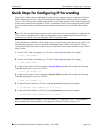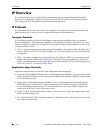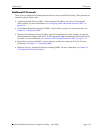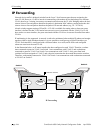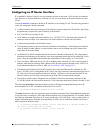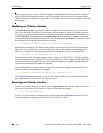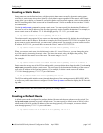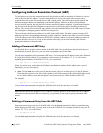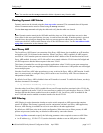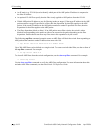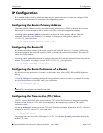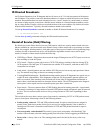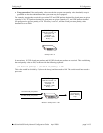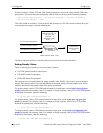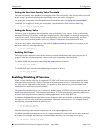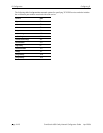
Configuring IP IP Forwarding
OmniSwitch 6600 Family Network Configuration Guide April 2006 page 14-11
Note. You can also use the no arp command to delete a dynamic entry from the table.
Clearing Dynamic ARP Entries
Dynamic entries can be cleared using the clear arp-cache command. This command clears all dynamic
entries. Permanent entries must be cleared using the no arp command.
Use the show arp command to display the table and verify that the table was cleared.
Note. Dynamic entries remain in the ARP table until they time out. If the switch does not receive data
from a host for this user-specified time, the entry is removed from the table. If another packet is received
from this host, the switch goes through the discovery process again to add the entry to the table. The
switch uses the MAC Address table timeout value as the ARP timeout value. Use the mac-address-table
aging-time command to set the timeout value.
Local Proxy ARP
The Local Proxy ARP feature is an extension of the Proxy ARP feature, but is enabled on an IP interface
and applies to the VLAN bound to that interface. When Local Proxy ARP is enabled, all ARP requests
received on VLAN member ports are answered with the MAC address of the IP interface that has Local
Proxy ARP enabled. In essence, all VLAN traffic is now routed within the VLAN instead of bridged and
all ARP requests are blocked between ports in the same VLAN.
This feature is intended for use with port mapping applications where VLANs are one-port connections.
This allows hosts on the port mapping device to communicate via the router. ARP packets are still bridged
across multiple ports.
Note that Local Proxy ARP takes precedence over any switch-wide Proxy ARP or ARP function. In addi-
tion, it is not necessary to configure Proxy ARP in order to use Local Proxy ARP. The two features are
independent of each other.
By default, Local Proxy ARP is disabled when an IP interface is created. To enable this feature, use the ip
interface command. For example:
-> ip interface Accounting local-proxy-arp
Note that when Local Proxy ARP is enabled for any one IP router interface associated with a VLAN, the
feature is applied to the entire VLAN. It is not necessary to enable it for each interface. However, if the IP
interface that has this feature enabled is moved to another VLAN, Local Proxy ARP is enabled for the
new VLAN and must be enabled on another interface for the old VLAN.
ARP Filtering
ARP filtering is used to determine whether or not the switch responds to ARP requests that contain a
specific IP address.This feature is generally used in conjunction with the Local Proxy ARP application;
however, ARP filtering is available for use on its own and/or with other applications.
By default, no ARP filters exist in the switch configuration. When there are no filters present, all ARP
packets are processed, unless they are blocked or redirected by some other feature.
Use the arp filter command to specify the following parameter values required to create an ARP filter:
• An IP address (e.g., 193.204.173.21) used to determine whether or not an ARP packet is filtered.



